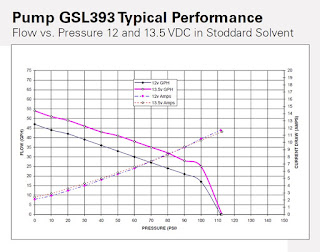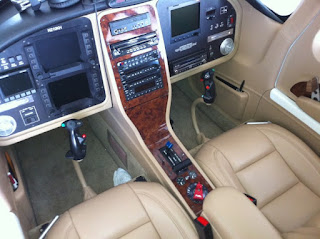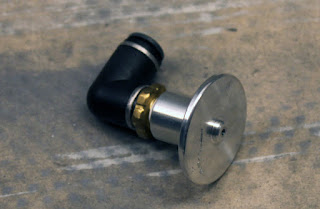So tonight instead of doing any actual "work" on the plane, I did some major research and planning on the brake and fuel systems. The brake system is fairly straightforward--at least the part in Section 36--which essentially runs two lines from the firewall area to the landing gear mount area. If you want to include the Matco parking brake, then it's a simple insertion into the lines "somewhere." Most folks install their parking brake valve on the firewall, but after reading a pretty descriptive (and hilarious) description from builder Myron Nelson about how difficult it is to reach the valve should it ever need servicing, I will be locating mine at the rear of the tunnel, where the brake lines diverge to go to the R and L sides. While unconventional, this location should be a lot easier to access in the future, and make for an easy control cable run in the tunnel. Pics and diagrams to follow.
Next, on to the fuel system. By far, this is the more complex, expensive, and thought-provoking system between the two. It is also a system that has been over-engineered and/or over-complicated by more than one builder, and sadly it is has also been at least a contributing cause for a number of fatalities in the experimental aircraft world, including the infamous accident that killed John Denver. There has even been one or two accidents involving RV-10's and poor fuel system design, although both of the ones I am aware of also involved highly modified automotive engine installations, which of course kind of throws all the usual stuff out the window to begin with. That's not what we're going for here.
What we ARE going for here though is what I'm going to call a "minor variation" on a tried-and-true system design, for two very specific reasons: (1) I am installing a fuel return line for future compatibility reasons, should I decide to install an electronic fuel injection system (e.g. EFII); (2) I will have provisions to connect a removable auxiliary fuel tank in the backseat or cargo area when extra endurance is required. Nothing too crazy, but any kind of modification needs to be considered very (and I mean VERY) carefully. So, we need to start with a standard RV-10 fuel system, analyze the crap out of it, and then (did I say carefully?) make our tweaks. So... keeping all this in mind, let's get started. Here is a diagram I made of a relatively standard, tried-and-true fuel system design to start with as a reference point.
"Standard" RV-10 fuel system design, IO-540 w/ Mechanical Injection
So I'm starting with this diagram above and calling it "Standard", but really there are already a few modifications depicted here. Notably, the check valves on each of the R/L vent systems, and individual pre-filters instead of the single filter at the boost pump module. The vent check valves are installed in each wing root and serve as a secondary vent, should the primary vent become clogged with ice (or a very unlucky bee). The individual prefilters simply separate the R/L fuel tanks a bit more, so that in the event one tank coughs up some really nasty gunk in the fuel and clogs the filter, you can still switch to the other tank and have unobstructed flow. These are two very common modifications that are pretty well documented already on other builders' sites, and I feel that they are both accepted pretty openly as safety improvements for protection against icing and fuel contamination.
So now, let's analyze the system a bit and look at the individual components, particularly the boost pump module. In the diagram above, the boost pump module is shown as three individual parts above the fuel selector: The check valve, the boost pump, and the regulator (or pressure relief valve). The way it works is best understood if we split into two distinct modes of operation: boost pump off and boost pump on.
- Boost pump off: Suction from the engine's mechanical fuel pump pulls fuel through the check valve and forward through the system. Fuel can technically also flow through the pump and its internal check valve (if present) but we will consider that a path of more resistance. Fuel does not flow through the regulator.
- Boost pump on: The pump pressurizes fuel going toward the engine, "forcing" fuel through the engine's mechanical pump and increasing system pressure, particularly at the inlet side of the mechanical pump, which is where vapor lock can occasionally occur. Due to this change in pressure, the check valve closes and prevents fuel from flowing backwards. Lastly, because the boost pump is capable of producing higher than desired pressure, the regulator opens for any excess of ~30psi and allows some fuel to return to the pump inlet.
Looking at the different boost pump modules available out there, I came across three different brands: The Van's-endorsed Airflow system, the Andair system, and the EFII system.
The ironically-named Airflow fuel pump module seems to have a number of happy customers, and it is Van's choice (always a plus), but it uses an Airtex fuel pump which is a brand I have quite a bit of personal experience with in the automotive world and regard them as inferior to just about any other kind out there. Furthermore, you can go buy the Airtex E2351 fuel pump used in that module for around $60, so I'm a little hard-pressed to cough up $500 to buy it.
The Andair pump looked awesome at first glance. Less external lines and fittings to go wrong, an internal regulator, and oh wow a BRUSHLESS motor! I've always wondered why brushless fuel pump motors haven't really caught on, it seems like they would be vastly superior to the traditional brushed motors in terms of both noise and longevity. Well, it turns out after reading a number of articles online about this particular pump that it is actually *louder* than others and there have been a number of failures, particularly early on due to some early design flaws. A rather disgruntled early-adopter made a video highlighting all the design flaws of this pump and posted it to Youtube, visible here. To be fair, it appears that the company has made improvements to the design since this time, and I am not aware of any recent failures of this pump. Even so, that was enough to make me move on, especially since this is the most expensive of the three options... the FPK-540 is priced at $850!
Finally we have the EFII module. This thing seems great-- it uses a Walbro brand pump (MUCH better than the Airtex in my opinion) and it has a custom check valve/regulator that boasts the lowest "cracking pressure" of the three available models. This means that the mechanical pump doesn't have to "pull" as hard to get fuel when the boost pump is off, which is a good thing especially at high altitudes or hot temperatures. And, it's very competitively priced at $649.
Between the three choices, to me the clear winner is the EFII module. There's just one thing left to consider though: the fuel return line that I have available on my system. If we take a second look at how these boost pump modules work, we can introduce an additional benefit that a true return line can provide. The way these modules are designed (in the absence of a return line) is that the regulator's return path is cut very short, sending fuel back only a few inches and re-introducing it at the inlet of the boost pump. With low demand from the engine (e.g. on descent), the majority of fuel follows this small circular path, absorbing heat from both the pumping process and the warm environment of the tunnel. Since we want our fuel to be as cool as possible for a number of reasons, this is not an ideal situation.
So, what if we pieced our system together instead of buying a pre-made module, using exactly the same kinds of parts as above, but allowed for the regulator to send fuel all the way back to the tanks? I spent hours online tonight, searching for pumps, check valves, and regulators, and I believe I have found a winning combination:
- Walbro GSL393 fuel pump ($98.18). This is (I believe) the exact same model of pump used in the EFII boost pump setup. It has exactly the right spread of pressures and flows to exceed the demands of a 260HP IO-540 engine without going way overboard. The larger GSL392 pump is somewhat more popular in the automotive world but it has significantly higher output, which really is unnecessary here. The GSL393's performance chart can be seen here:
Walbro GSL393 Pump Performance
McMaster-Carr 47715K21 check valve ($30.07). This valve has 0.5psi cracking pressure (VERY low) and PTFE seals that work well with all kinds of fuels and in a wide range of temperatures. I had originally considered some other valves with Buna-N (nitrile) or Viton seals, but nitrile doesn't hold up to certain kinds of fuel additives, and Viton doesn't perform well in cold temperatures (below around +10 deg F). I actually spent considerably more time than I thought I would looking at check valves, there are a lot of different options out there and care must be taken to choose the right one.
(EDIT 9/2/15: After further research, I've selected the Parker 2625 "Swing-type" check valve, price TBD. This valve is aluminum instead of brass, and has a fluorocarbon seal with even greater temperature range, and is designed specifically for fuel systems like this)- Aeromotive 13301 Fuel Pressure Regulator ($131.94). This regulator is adjustable between 3-65psi (30psi desired here), and will work perfectly to send excess fuel back to the tanks. It is also rebuildable and seems to have a strong history of reliability.
(EDIT 9/2/15: A simpler method may be to use a standard relief valve with 25 or 30psi rated pressure. I'm torn between the two options and will keep searching on this.)
N165MJ Fuel System Design - First Draft
If you've been following along from the previous diagram, you'll see that really not much has changed except for the "duplex" fuel selector, the location of the pressure regulator, and the path of the returned fuel. I'm going to stew on this design for a little while and figure out the number of connectors, tees, fittings, etc etc that will be necessary to make this all work, and go from there. In the meantime, please feel free to comment (or email me) your ideas or opinions on this design! I welcome all feedback.
One other thing left to cover is the aux tank connections, but that is fairly simple in design. My plan there is to have two fittings and an electrical connector hidden somewhere in the R interior side wall that I will connect to a custom ~20gal fuel cell that can be placed in the rear seat floor or baggage compartment. Fuel will be burned from both main tanks as normal, and then when a tank has enough room in it to accomodate the fuel from the cell, an electric transfer pump inside the cell will be activated to refill the selected tank (either right or left) through the return line. It should work pretty slick... or at least that's the hope.
Whew! Sorry for such a long post tonight. Hopefully I've been able to document my current thoughts in a clear way. Excited to see how this all plays out!




